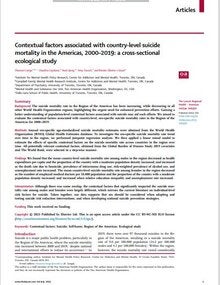Summary
Background
The suicide mortality rate in the Region of the Americas has been increasing, while decreasing in all other World Health Organization regions; highlighting the urgent need for enhanced prevention efforts. Gaining a better understanding of population-level contextual factors associated with suicide may aid such efforts. We aimed to evaluate the contextual factors associated with country-level, sex-specific suicide mortality rates in the Region of the Americas for 2000–2019.
Methods
Annual sex-specific age-standardized suicide mortality estimates were obtained from the World Health Organization (WHO) Global Health Estimates database. To investigate the sex-specific suicide mortality rate trend over time in the region, we performed joinpoint regression analysis. We then applied a linear mixed model to estimate the effects of specific contextual factors on the suicide mortality rate across countries in the region over time. All potentially relevant contextual factors, obtained from the Global Burden of Disease Study 2019 covariates and The World Bank, were selected in a step-wise manner.
Findings
We found that the mean country-level suicide mortality rate among males in the region decreased as health expenditure per capita and the proportion of the country with a moderate population density increased; and increased as the death rate due to homicide, prevalence of intravenous drug use, risk-weighted prevalence of alcohol use, and unemployment rate increased. The mean country-level suicide mortality rate among females in the region decreased as the number of employed medical doctors per 10,000 population and the proportion of the country with a moderate population density increased; and increased when relative education inequality and unemployment rate increased.
Interpretation
Although there was some overlap, the contextual factors that significantly impacted the suicide mortality rate among males and females were largely different, which mirrors the current literature on individual-level risk factors for suicide. Taken together, our data supports that sex should be considered when adapting and testing suicide risk reduction interventions, and when developing national suicide prevention strategies.
Funding
This work received no funding.
|

